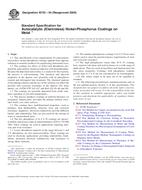Potrebujeme váš súhlas na využitie jednotlivých dát, aby sa vám okrem iného mohli ukazovať informácie týkajúce sa vašich záujmov. Súhlas udelíte kliknutím na tlačidlo „OK“.
ASTM B733-04(2009)
Standard Specification for Autocatalytic (Electroless) Nickel-Phosphorus Coatings on Metal
Automaticky preložený názov:
Štandardné špecifikácie pre autokatalyticky ( Chemické ) niklu a fosforu nátery na kov
NORMA vydaná dňa 1.9.2009
Informácie o norme:
Označenie normy: ASTM B733-04(2009)
Poznámka: NEPLATNÁ
Dátum vydania normy: 1.9.2009
Kód tovaru: NS-7887
Počet strán: 14
Približná hmotnosť: 42 g (0.09 libier)
Krajina: Americká technická norma
Kategória: Technické normy ASTM
Anotácia textu normy ASTM B733-04(2009) :
Keywords:
autocatalytic, chemical nickel, coatings, conductive, corrosion resistance, electroless, functional, nickel, nickel phosphorus, wear resistance, Autocatalytic coatings--specifications, Electroless coatings, Engineered electrodeposited coatings--specifications, Metallic coatings--specifications, ICS Number Code 25.220.40 (Metallic coatings)
Doplňujúce informácie
| 1. Scope | ||||||||||||||||||||||||||||||||||||||||||||||||||||||||||||||||||||||||||
|
1.1 This specification covers requirements for autocatalytic (electroless) nickel-phosphorus coatings applied from aqueous solutions to metallic products for engineering (functional) uses. 1.2 The coatings are alloys of nickel and phosphorus produced by autocatalytic chemical reduction with hypophosphite. Because the deposited nickel alloy is a catalyst for the reaction, the process is self-sustaining. The chemical and physical properties of the deposit vary primarily with its phosphorus content and subsequent heat treatment. The chemical makeup of the plating solution and the use of the solution can affect the porosity and corrosion resistance of the deposit. For more details, see ASTM STP 265 (1) and Refs (2) (3) (4) and (5). 1.3 The coatings are generally deposited from acidic solutions operating at elevated temperatures. 1.4 The process produces coatings of uniform thickness on irregularly shaped parts, provided the plating solution circulates freely over their surfaces. 1.5 The coatings have multifunctional properties, such as hardness, heat hardenability, abrasion, wear and corrosion resistance, magnetics, electrical conductivity provide diffusion barrier, and solderability. They are also used for the salvage of worn or mismachined parts. 1.6 The low phosphorus (2 to 4 % P) coatings are microcrystalline and possess high as-plated hardness (620 to 750 HK 100). These coatings are used in applications requiring abrasion and wear resistance. 1.7 Lower phosphorus deposits in the range between 1 and 3 % phosphorus are also microcrystalline. These coatings are used in electronic applications providing solderability, bondability, increased electrical conductivity, and resistance to strong alkali solutions. 1.8 The medium phosphorous coatings (5 to 9 % P) are most widely used to meet the general purpose requirements of wear and corrosion resistance. 1.9 The high phosphorous (more than 10 % P) coatings have superior salt-spray and acid resistance in a wide range of applications. They are used on beryllium and titanium parts for low stress properties. Coatings with phosphorus contents greater than 11.2 % P are not considered to be ferromagnetic. 1.10 The values stated in SI units are to be regarded as standard. 1.11 The following precautionary statement pertains only to the test method portion, Section 9, of this specification. This standard does not purport to address all of the safety concerns, if any, associated with its use. It is the responsibility of the user of this standard to establish appropriate safety and health practices and determine the applicability of regulatory limitations prior to use. X1.1.1 This test method will evaluate the resistance of the coating to abrasive wear. The test is performed by rotating a plated panel under rotating rubber wheels and weighing the panel after each 1000 cycles for weight loss. Duration of the test is 6000 cycles and it can be extended to 25 000 cycles for more complete results. Note X1.1—Variation in results have been attributed to the humidity in the laboratory and the storage conditions of the CS-10 wheels. Care should be taken to control the humidity between tests. X1.1.2 The results are variable between tests and therefore three plated test specimens should be tested to 6000 cycles each. The results should be averaged without the first 1000 cycles and the abrasion wear resistance is reported as the weight loss in mg/1000 cycles (Taber Wear Index). |
||||||||||||||||||||||||||||||||||||||||||||||||||||||||||||||||||||||||||
| 2. Referenced Documents | ||||||||||||||||||||||||||||||||||||||||||||||||||||||||||||||||||||||||||
|
Odporúčame:
Aktualizácia technických noriem
Chcete mať istotu, že používate len platné technické normy?
Ponúkame Vám riešenie, ktoré Vám zaistí mesačný prehľad o aktuálnosti noriem, ktoré používate.
Chcete vedieť viac informácií ? Pozrite sa na túto stránku.




 Cookies
Cookies
